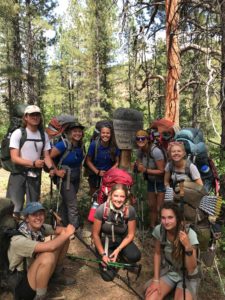
Our first day of section two on the Colorado Plateau with the Wild Rockies Field Institute (WRFI), we hike five miles into Dark Canyon Wilderness, formerly part of the recently reduced Bears Ears National Monument. Prior to entering Dark Canyon Wilderness, my mind is foggy. Troubles of the past haunt my brain. Loss, uncertainty and mistakes are at the forefront of my thoughts. As we begin our entrance and decent into the canyon, ponderosa and birch trees flood my vision; a dense desert forest. The sounds of bird song, scuttling squirrels and insects buzzing reach my ears. Smells of pine needles, wildflowers, and animal scat infiltrate my nasal cavities. But my mind is still held down by troubled memories and the impending anxious future.
We hike into what is known as Woodenshoe Canyon, which will be our home for a while. Conversations of my comrades float past me as we walk. Finally, we arrive at our first campsite, our feet and backs tired from our heavy packs, ready to rest our bodies. The night is cold, and it is met with an even colder morning. Our hot drinks and extra layers prevent us from locking up like ice cubes. After breakfast, our class meets in a circle near an empty fire pit, just as the rising sun begins to post over the canyon walls. In class we discuss systems thinking and inter-connectivity: the concept that you relate all things back to part of a system, by recognizing all things are connected. For example, the soil connected to the plants which require its nutrients, insects connected to the plants for sustenance, insects connected to the reptile which consume them, and so on, all part of a greater system – or ecosystem.
The next day we head further into Woodenshoe Canyon, an eight-mile hike to our next campsite. The landscape of this canyon is beyond what I’ve ever seen. The white sandstone walls contrasted by the dark green of coniferous trees surrounds my peripherals. As we continue our travels, these canyon walls get taller and taller, almost like large mountains, as we walk between narrow and dry valleys. I observe interactions between lizards and insects in the shrubbery as we march by, denoting the constant flow of life. After a long day baking under the sun, we arrive at our next campsite.
Our next class discussion is on the topic of Wilderness. What is its purpose? Who is it available to? Where does the idea come from? And who can lay claim to it? The state or federal governments? The original Indigenous people? The American public? Or the natural ecosystems of flora and fauna that evolved here and are most dependent on the land? Perhaps the human purpose of wilderness, and how it can be valuable to us, can be looked through the lens of escapism. Perhaps it allows us to have a better understanding of the world we live in and how we are all connected. There are many ways to escape the busy lives that we feel drawn to. Technology, media, and substances, are some ways that we can remove ourselves from societal clutches. However, in my view, the great outdoors can be the most involved, immersive, and productive way of escapism. It provides a greater sense of self, and a greater understanding that you are a product, as well as a part of something larger than you as an individual. In this canyon, I truly feel small, but connected, and the whole wouldn’t be the same without me.
By the next day, we head out for another hike, entering Dark Canyon itself. We enter wide stretches of flat land on both sides of the empty washes. The canyon walls seem to max out their own heights. They also seem to separate, creating vast spaces of land in between. These spaces are littered with juniper and ponderosa trees, sagebrush, saltbrush, and rabbitbrush shrubs, and the countless number and diversity of wildflowers. We are encompassed by the ancient geology and lively vegetation. I feel fully involved in the present moment. The worries and troubles of the life I left behind cease to exist in this Wilderness, whatever that word means. Perhaps it depends purely on the individual, with no true agreement of the definition.
Being around my companions fills me with a sense of community, as we converse and laugh until our stomachs ache. We are growing to understand that we are not only ourselves, but a group, dependent on one another, eager to share and allow ourselves to be a part of something larger than individuals. By the time we exit Dark Canyon, enter Peavine Canyon, and begin our trek to the trailhead, we gain the realization that we are all interconnected, forming a community, or a system of our own.
One Reply to “Michael Helton: What is Wilderness?”
Comments are closed.
Michael I love your description of your being, your soul, your fellow mates and your journey. I can see you, feel you and admire you for seeking your persona. Son you have a gift pursue it, nurture it and you will find that lesson and always share it because you never know when that seed will blossom. The Lord bless you and your fellow mates. Love you Paw